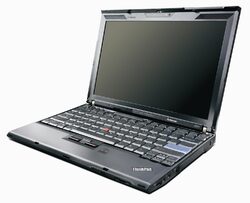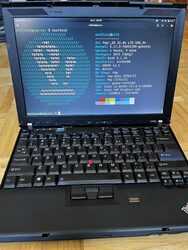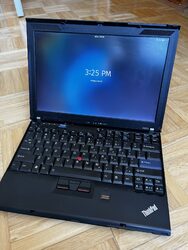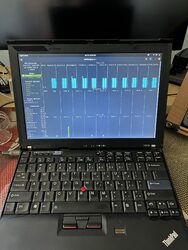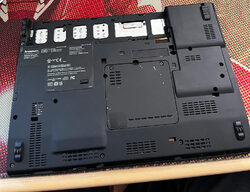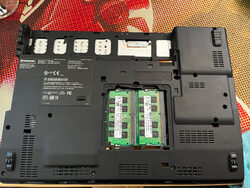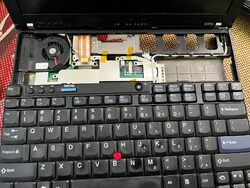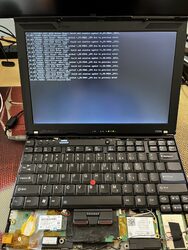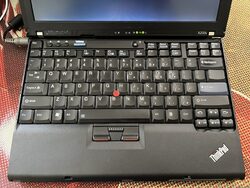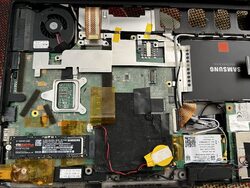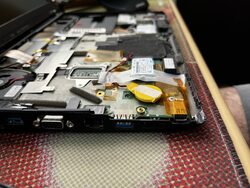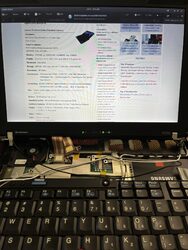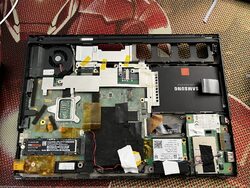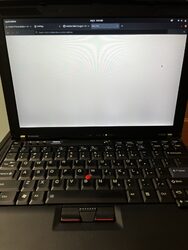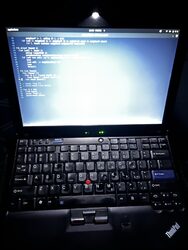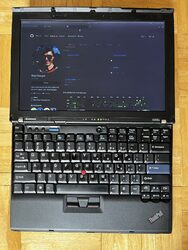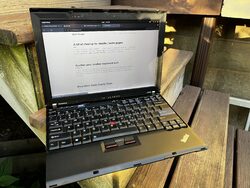on
My Ship of Theseus laptop: the 51nb X210
I’ve had several Linux laptops over the years, but I haven’t blogged about most of them because I don’t consider myself a hardware reviewer and others typically review laptops much better than I could. I’ve always had an interest in small laptops that I can bring everywhere. My first laptop was a Powerbook G4 12” in college, and I’ve been chasing the ergonomics of having a small 12” laptop with me at all times ever since. Rather than talk about the Linux laptops I’ve tried and gotten rid of, I wanted to write this to cover a rather unique Linux laptop that I now have.
Background on the X201
In 2010, Lenovo revamped the Thinkpad X200, which had a Core 2 Duo processor, into the Thinkpad X201. Compared to today, compact laptop designs like the X201 still carried a chunky shape with an array of ports. These laptops had keyboards with actual key travel and a trackpoint for pointing. They still had full size ports for VGA, ethernet, and an externally accessible drive bay. But the X201 laptops also ran some of the first Intel Core processors, replacing the hot and slow Core 2 Duos of the past. The X201 laptops were very portable, very light, and they had all the durability of IBM/Lenovo Thinkpads. This was also an era when laptops were still expected to have an internal optical disk, and many reviews of the X201 from this era mention this tradeoff that the X201 didn’t have one. Today, there are few laptops with an internal optical disk and so the choice makes more sense.
To go one step further from what we expect, this laptop has a removable battery. That’s almost unheard of in 2022!
For this particular platform, an enthuasist group in China called 51nb decided to make a modern motherboard with 8th-gen Intel processors. The group has been working on retrofitting older Thinkpads with newer internals for some time before this project. They dubbed this upgraded laptop the 51nb X210. In addition to the 8th-gen Intel CPUs, the new motherboard replaces the Expresscard slot with a Mini Display Port and upgrades two USB ports to USB 3.0, but keeps most of the original ports intact and working. Newer, higher resolution displays became available by the addition of another display connector on the motherboard – the X201 only shipped with a 1366x768 display and only a few rarer X200s models shipped with 1440x900 displays.
The design got some attention outside of the group, ending up on places like Hacker News and Lobsters, where I became aware of it back in 2018 or so. In total, 51nb produced 3 batches of motherboards that were then either sold bare or put into laptops. The company XY Tech would eventually revise the design with 10th-gen Intel CPUs, some new ports, and even more display options, dubbing their batch the X2100.
How I found one
While I never felt compelled to order a custom built X210 from 51nb, I kept an eye out online for them. My interest dropped for awhile (pandemic, and so on) until I was looking to replace my personal laptop earlier this year. I ended up finding an X210 on the thinkpadsforsale subreddit, and purchased it off of the specs (i5, an nvme SSD, the x200s 1440x900 screen swapped in) and some photos that didn’t really show the condition. The 8th-gen Intel i5’s are, in my opinion, still decent CPUs. They are relatively power efficient and run cool enough on battery for a laptop, but are powerful enough to use for programming tasks. This turns out to be my second Thinkpad ever.
Sidebar: my X1 Extreme
I had a refurbished Thinkpad X1 Extreme (gen 1) for several years after its introduction in 2018, and I had purchased it thinking (at the time) that I’d use the Nvidia graphics card for ML and data science work. Early on with the X1 Extreme, I realized a laptop with a hexacore Intel CPU and a discrete graphics card was both power-hungry and had quirks on Linux, like requiring a full reboot to switch graphics mode. It took several years for the Linux kernel improve support for this laptop, at which point I’d mostly abandoned trying to use a laptop for browsing, gaming, or consuming videos – I default to my phone these days. Only in the last 2 years have things like the fingerprint reader on the X1 Extreme started working. It was oddly a computer that got better with age – at least on Linux – as compared to most computers which get slower and worse the older they are. In the end, I decided it was just too overkill with its hungry CPU, graphics card, and 15” 4K touchscreen – just too much to carry around.
My X210
The X210, by contrast, worked almost perfectly in Linux out of the box with a fresh install of PopOS 22.04 LTS. It slept and woke up fine, TLP configured power savings (and I pulled a few more tweaks from powertop), wifi was stable, and the special keys for screen brightness and volume all worked in Linux. All things you would expect out of a Thinkpad. I upgraded the BIOS and firmwares according to the instructions on the GitHub repo harrykipper/x210, but I did not choose to install Coreboot at this time. Coreboot does work on this laptop thanks to work done by Matthew Garrett.
Early on, after the TLP+powertop tweaks, I set it up for the day running on only the battery-of-unknown-health and queued up a session with emacs, Firefox running a Youtube lofi stream (which also kept it from sleeping), and a few processes in a terminal emulator. I ended up letting it run (without sleeping) for over 9 hours before I declared the battery life test a success. Granted, I wasn’t using it all day in that state, but I did use it after work in the evening to browse the web and read some PDF papers while the test was still ongoing. I’m fairly certain that a brand new replacement battery would have even more runtime, but I haven’t felt compelled to try it. I did run into issues trying to find a new-old-stock Lenovo battery that charged in this device, because I wanted to have a spare, but I am not sure why.
The size is comparable to a 13” Macbook Air (I had a mid-2013 MBA to compare it to), but much thicker at the hinge end. It feels sturdy, but it is not quite as rigid as the unibody laptops made now, and the keyboard being essentially a sheet metal tray does allow for some keyboard flex if you type hard or push on it.
This laptop has been really fun to work on. You only need a #0 Philips screwdriver – no special lobed bits. Few laptops these days can really be opened up: Most laptops now feature RAM soldered to the motherboard. This laptop, by contrast, has now been opened up several times in which I’ve removed everything down to the chassis and motherboard for inspection or upgrade. Just having a battery and externally-accessible hard drive slot is very satisfying. The keyboard is held in by several screws on the bottom, along with the palm rest, and once those are removed, more screws allow the motherboard to be removed if you so wish, leaving the display cables and a small x201-original daughterboard with audio jacks, a USB 1.0 port, and a slow SD card reader.
I cannot say that the condition of the laptop I received matched my hopes, however. I know this is a 2010-era device/chassis, and there are almost no new-old-stock parts available for them anymore. It is important to remember that most of the parts comprising this laptop have likely been used for a decade or more.
My particular laptop had a worn keyboard that seemed to have been bent down around the Q key. The keyboard also had accrued years of gunk and someone’s pet’s hair. The laptop smelled suspiciously strong, as if some previous owner had both chain-smoked cigarettes and sprayed burnt incense. Some cleaning with alcohol on the surfaces of the chassis helped a bit with the smell, but replacing the keyboard became my top priority. While I was at it, I also found a new-old stock palm rest on eBay for an x200/x201 that did not have a fingerprint reader. The old fingerprint readers don’t work with this particular 51nb motherboard, as far as I can tell, so it was no loss for a cleaner palm rest.
The new keyboard that I got does have some wear (it seems that there are no new “classic” keyboards from this era out there, so everything was removed from another laptop), but it feels great. It is more solid and the key travel feels nicer than the one it replaced.
I could have replaced the SSD at the same time as the keyboard and the palm rest, but it actually waited until I found the right SSD, and I opened it up again for that change. The Samsung 970 Evo Plus is as fast as the PCI lanes in the nvme interface can handle here, so no need to buyer a faster SSD. Once again, it was fun to be able to open up a computer and “do a little work on it.”
There is still a missing cover where the Expresscard used to be (and the Mini Display Port now resides), and I have a plan to eventually model and 3D print a plate to cover that area, but haven’t done it yet.
I’ve also since bought another X200s 1440x900 display – the one that came in mine does have a dead pixel and some sort of pattern from the backlight. Besides the particular flaws of the existing display, I believe these are old TN TFT displays – very directional, and with a bit of what I’d call “backlight bleed” compared to the display we are used to now.
I had hoped to put in a 3000x2000 display panel sold by XY Tech, and I discussed this with them. But it turns out the particular revision of my laptop does not have the right connectors on the motherboard. There are a few panels in 1080p resolution that I could upgrade to, but as mentioned in Geoff Greer’s review, the panel is just slightly larger than the stock bezel. I have not decided on whether to try the 1080p upgrade, but the upgrade in resolution, the backlight brightness, and IPS panel technology would probably make a big difference.
The second 1440x900 display (from another X200s) from eBay worked fine and had no dead pixels or backlight blemishes, so I’ve since swapped it in, too. Anyone want a spare, beat up X200s display?
Usage
I’ve talked about how neat it is to be able to service the laptop rather than have a laptop that is sealed shut and all soldered together. But what do I think about it as a daily driver? It’s perfectly capable, as I said, of all the kinds of tinkering with programming that I do on a personal machine. For me, that means running a few emacs windows, Firefox with a bunch of tabs, and a few terminal programs in Alacritty. Lately, I’ve also been getting back into 3D printing and running PrusaSlicer. The X210 is a good little laptop for carrying around the house by the extended cell battery, which forms a sort of handle. The keyboard is extremely satisfying – I still prefer a mechanical keyboard for my daily work at a desk, but this is much, much better than the keyboards you get in Apple laptops or modern Thinkpads.
That all said, I didn’t end up moving my personal programming environment fully to this laptop and getting it set up as my “main” computer. that kept me from treating this install as something I wanted to “set up” fully and get keys onto GitHub for.
The X210 will drive a larger display through its Mini DisplayPort, but I am not in the habit of keeping the extra cable around on my desk and swapping keyboard/mouse to it. (And my 4K display doesn’t particularly like HDMI signals or something about the mDP->HDMI cable, but that’s a different issue.) I’d much prefer to be able to swap a personal laptop in to my “work” desk setup – plugging in the single Type-C connector that goes to my Thunderbolt dock, and then out to my monitor, keyboard, a mouse, and a nice webcam for video meetings. When mobile, I prefer a higher DPI screen, and the particular X210 I have can only really support a 1080p display upgrade.
The wifi is somewhat slow compared to a new laptop, measuring at only around 25 mbps down. I happened to test the wifi speed after I replaced the display, to make sure the antenna cables had been seated. But I didn’t get a speed test before that. It is possible that the wifi card can be upgraded, like most things on this laptop, but the speed is “good enough” right now – I am not using this laptop for video calls, and the Linux driver support for the Intel card is good.
There a few fun features that you won’t find on modern laptops, like the Thinklight instead of a backlit keyboard, and the ability to open the screen hinge all the way flat.
Will I keep the X210? For the time being, yes, it’s a neat little laptop to tinker with. I do have some concerns – mostly around the fact that the motherboards are not available anymore, and some people have had issues with shorting or mechanical stress from carrying the laptop in a backpack or similar. Everything else on it can basically be replaced with relatively-cheap used parts from eBay and I have already replaced a long list of things, which is why I’ve decided to give it the hostname ‘theseus’ after the Ship of Theseus.
If you’re interested in something similar, your best bet is to reach out to XY Tech, as I understand they’re continuing to find ways to make various old Thinkpad models new again.
References / more info:
